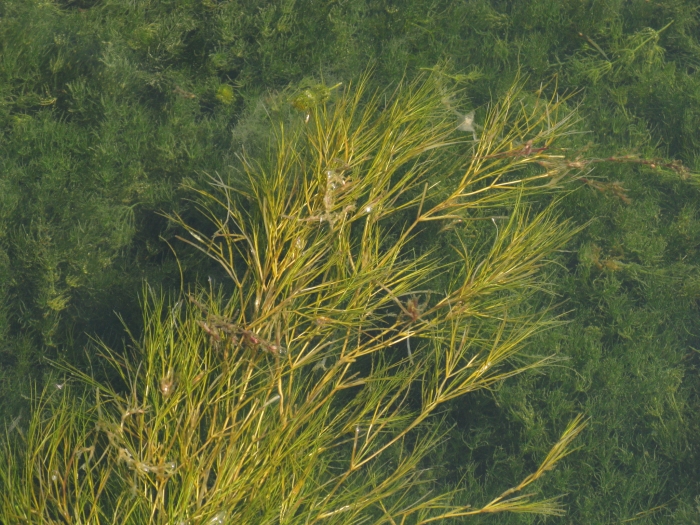Sago Pondweed
(Stuckenia pectinata)
Sago Pondweed (Stuckenia pectinata)
/
/

Igor Balashov
CC BY 4.0
Image By:
Igor Balashov
Recorded By:
Copyright:
CC BY 4.0
Copyright Notice:
Photo by: Igor Balashov | License Type: CC BY 4.0 | License URL: http://creativecommons.org/licenses/by/4.0/ | Rights Holder: Igor Balashov | Publisher: iNaturalist | Date Created: 2021-08-05T10:32:53-07:00 |
















Estimated Native Range
Summary
Stuckenia pectinata, commonly known as sago pondweed or fennel pondweed, is a perennial, fully submerged aquatic plant. It is native to a wide range of freshwater and brackish water habitats including lakes, ponds, slow-moving rivers, and protected coastal bays around the world, except Antarctica. This species often forms dense underwater meadows and is an important food source for waterfowl and aquatic life. Stuckenia pectinata typically has long, narrow, and thread-like leaves that resemble fennel, hence one of its common names. It produces inconspicuous wind-pollinated flowers and reproduces both vegetatively via tubers and sexually through seeds. The plant can reach lengths of several meters under the water surface.
In cultivation, sago pondweed is valued for its ability to oxygenate water, provide habitat for aquatic organisms, and its use in waterfowl management areas. It is also used in aquariums and ornamental ponds. Sago pondweed prefers full sun conditions and can grow in a variety of water types, from fresh to mildly brackish. While it is not demanding in terms of water nutrients, it thrives in clear waters where sunlight can penetrate to the bottom. Care should be taken when introducing this species into non-native areas, as it can become invasive and outcompete native vegetation. It is advisable to consult local regulations before planting.CC BY-SA 4.0
In cultivation, sago pondweed is valued for its ability to oxygenate water, provide habitat for aquatic organisms, and its use in waterfowl management areas. It is also used in aquariums and ornamental ponds. Sago pondweed prefers full sun conditions and can grow in a variety of water types, from fresh to mildly brackish. While it is not demanding in terms of water nutrients, it thrives in clear waters where sunlight can penetrate to the bottom. Care should be taken when introducing this species into non-native areas, as it can become invasive and outcompete native vegetation. It is advisable to consult local regulations before planting.CC BY-SA 4.0
Plant Description
- Plant Type: Herb
- Height: 0.5-3 feet
- Width: 1-3 feet
- Growth Rate: Rapid
- Flower Color: Green
- Flowering Season: Spring, Summer, Fall
- Leaf Retention: Deciduous
Growth Requirements
- Sun: Full Sun
- Water: High
- Drainage: Standing
Common Uses
Low Maintenance, Water Garden
Natural Habitat
Freshwater and brackish water habitats including lakes, ponds, slow-moving rivers, and protected coastal bays
Other Names
Common Names: Large-leaf Pondweed, Sago Pondweed, 솔잎가래, Fennel Pondweed, Fennel-Leaf Pondweed, Pondweed
Scientific Names: , Stuckenia pectinata, Buccaferrea pectinata, Coleogeton pectinatus, Coleogeton pectinatus, Coleogeton pectinatus subsp. balatonicus, Potamogeton acifolius, Potamogeton angustifolius f. longipedunculatus, Potamogeton angustissimus, Potamogeton balatonicus
GBIF Accepted Name: